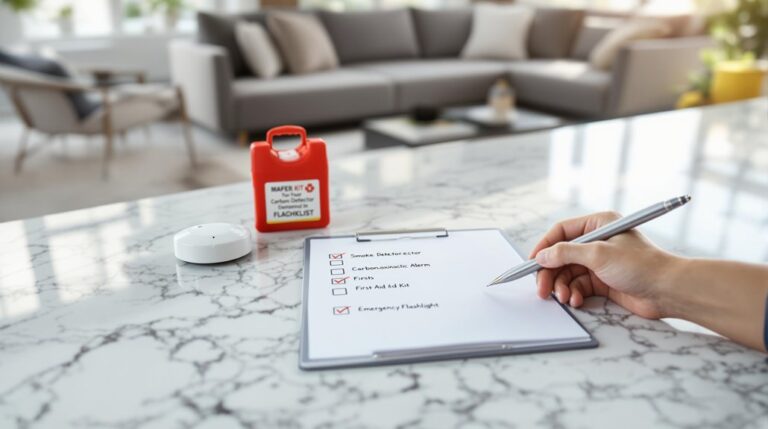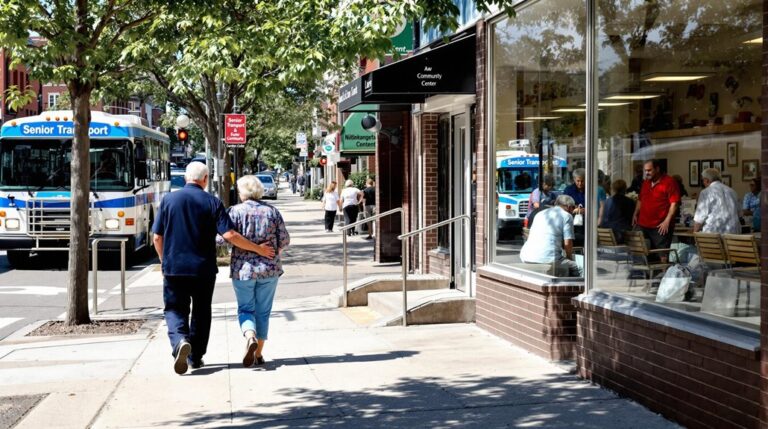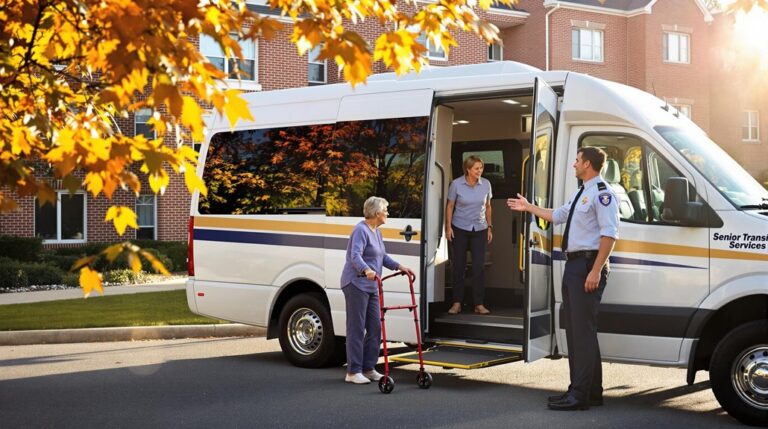Falls among older adults pose a serious health threat, affecting one in four seniors annually and often leading to life-altering injuries. While these statistics are concerning, implementing proven prevention strategies can dramatically reduce the risk of falls and maintain independence. From simple home modifications to targeted exercise programs, seniors and their caregivers have access to numerous effective solutions that protect both health and quality of life. What makes these prevention methods particularly valuable is their immediate impact on safety.
Key Takeaways
- Remove tripping hazards like loose rugs, electrical cords, and clutter from walkways to create clear paths throughout the home.
- Install proper lighting, including motion-sensor lights and night lights, especially in hallways, stairways, and bathrooms.
- Add grab bars near toilets and in showers, and use non-slip mats in bathrooms where falls commonly occur.
- Exercise regularly with balance-focused activities like tai chi and strength training to improve stability and reduce fall risk.
- Review medications with healthcare providers, as certain prescriptions can affect balance and increase fall risks.
Understanding the Hidden Dangers of Falls in Older Adults

While falls are often viewed as simple accidents, they represent one of the most serious health risks facing older adults today. Recent fall statistics reveal that over 38,700 seniors died from unintentional falls in 2021, highlighting the severity of this public health concern.
Beyond immediate trauma, injury complications can cascade into serious health issues, including pneumonia and pressure injuries, particularly when mobility becomes limited.
The consequences extend far beyond physical harm, as many older adults experience anxiety and social withdrawal following a fall. This psychological impact often leads to reduced independence and increased isolation.
Falls shatter more than bones – they break confidence, leading many seniors to retreat from life’s activities and social connections.
Vision impairments associated with aging further compound these risks, creating a cycle of declining health and heightened vulnerability that requires immediate attention from healthcare providers and family members.
Key Risk Factors That Make Seniors More Vulnerable
Five essential risk factors contribute greatly to falls among seniors, creating a complex web of vulnerabilities that can severely impact their safety and independence.
Physical decline, marked by balance impairments and muscle weakness, fundamentally alters mobility patterns. Chronic health conditions, particularly diabetes and cardiovascular issues, compound these challenges through reduced sensory feedback and dizziness.
Medication side effects from commonly prescribed drugs can impact coordination and stability, while psychological factors like depression and fear of falling often lead to reduced activity levels.
Additionally, age-related vulnerabilities, including reduced sensation in extremities and prolonged periods of inactivity, further increase fall risks.
Understanding these interconnected factors is vital for developing effective prevention strategies and maintaining senior safety.
Creating a Fall-Safe Home Environment

Because seniors spend a considerable portion of their time at home, creating a fall-safe living environment represents one of the most crucial steps in preventing accidents and maintaining independence.
Effective clutter management begins with removing tripping hazards like loose wires and securing area rugs with non-slip backing. Strategic lighting enhancements, including motion-activated fixtures and night lights in hallways and bathrooms, greatly improve navigation safety throughout the home.
Structural modifications further enhance safety through the installation of handrails, grab bars, and non-slip surfaces in critical areas.
The bathroom, particularly vulnerable to falls, requires specific attention through modifications such as walk-in showers, elevated toilet seats, and textured flooring.
Regular home safety assessments by occupational therapists can identify additional risks and recommend tailored solutions for aging residents.
Essential Balance and Strength Exercises for Prevention
Physical exercise stands as a powerful tool in preventing falls among seniors, complementing the safety measures implemented within their homes.
A thorough approach combining balance exercises and strength training has shown remarkable effectiveness, reducing fall rates by up to 24%. Essential balance exercises include standing on one leg, heel-to-toe walking, and practicing tai chi, while effective strength training focuses on resistance band work and squatting exercises that target the lower body and core muscles.
Multi-component programs that merge these exercises with aerobic activities offer the most considerable benefits. Activities like structured walking routines and dance-based exercises enhance coordination while building endurance.
When performed consistently, these exercises improve walking speed, strengthen protective mechanisms, and greatly lower the risk of recurrent falls.
Medication Management to Reduce Fall Risks
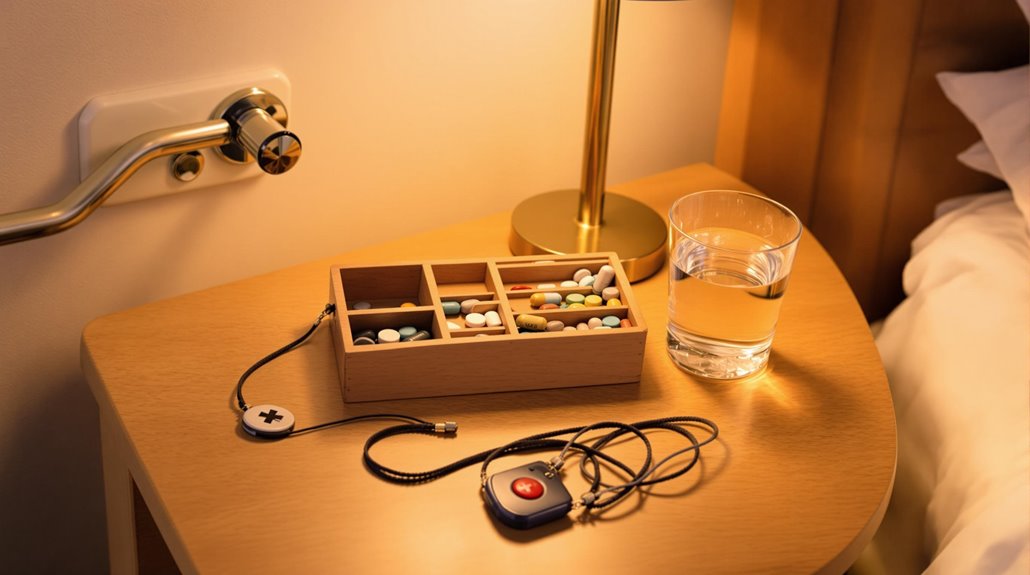
While regular exercise plays an essential role in fall prevention, proper medication management stands equally important for seniors’ safety and well-being.
Recent studies show that 94% of older adults face increased fall risks due to their medications, particularly from antidepressants, antipsychotics, and blood pressure medications. These risks become more significant with higher dosages and multiple prescriptions.
Regular medication review with healthcare providers can identify potentially dangerous drug combinations and opportunities for dosage adjustment.
Reviewing medications regularly with your healthcare team helps spot risky drug interactions and find ways to optimize your dosages safely.
Pharmacists can conduct thorough assessments using tools like the STEADI-Rx toolkit to screen for fall risks. When appropriate, doctors may recommend gradually reducing certain medications or exploring non-pharmaceutical alternatives.
Being open with healthcare providers about any falls or medication side effects guarantees proper adjustments to maintain both health and safety.
The Role of Regular Vision and Hearing Checks
Regular vision and hearing checks emerge as essential components in preventing falls among seniors, with studies revealing their substantial impact on overall safety and well-being.
Research indicates that 28% of older adults report vision impairment, while 60% experience hearing difficulties, making routine screenings vital for fall prevention.
- Vision screening can identify correctible issues that contribute to falls, potentially saving $237-$423 million in healthcare costs.
- Hearing assessments help determine the need for assistive devices, as hearing aid users show a markedly lower fall risk compared to unaided individuals.
- Combined sensory evaluations are particularly important since vision and hearing impairments together amplify fall susceptibility, especially in adults aged 80 and older who experience vision impairment rates up to 26%.
Smart Technology and Safety Devices for Prevention
As technological advancements continue to reshape healthcare solutions, smart devices and innovative safety technologies have emerged as powerful tools in fall prevention for seniors.
Smart home automation systems now incorporate motion sensors, adaptive lighting, and environmental monitoring to create safer living spaces. These systems can detect potential hazards like slippery floors and automatically adjust conditions to prevent accidents.
Wearable technology has revolutionized fall prevention through real-time monitoring and early warning systems. Smartwatches equipped with accelerometers track movement patterns and can immediately alert caregivers if a fall occurs.
These devices also provide balance feedback and activity tracking, encouraging seniors to maintain regular physical activity while monitoring their safety. The integration of these technologies with healthcare systems guarantees thorough fall prevention strategies that protect seniors while preserving their independence.
Working With Healthcare Providers on Prevention Plans
Effective fall prevention strategies require strong partnerships between seniors and their healthcare providers. Regular provider engagement through thorough screenings, medication reviews, and post-fall assessments helps identify and address potential risks before accidents occur.
Healthcare teams coordinate interdisciplinary prevention strategies, utilizing evidence-based programs like STEADI and Healthy Steps in Motion to enhance patient safety.
- Schedule regular appointments to discuss fall history, medications, and concerns about balance or mobility
- Participate in recommended physical assessments and follow through with referrals to specialists like physical therapists
- Document any falls or near-misses between visits to help providers identify patterns and adjust prevention plans accordingly
These collaborative approaches guarantee seniors receive personalized care while maintaining their independence through proven fall prevention methods.
Cost-Effective Home Modifications That Matter
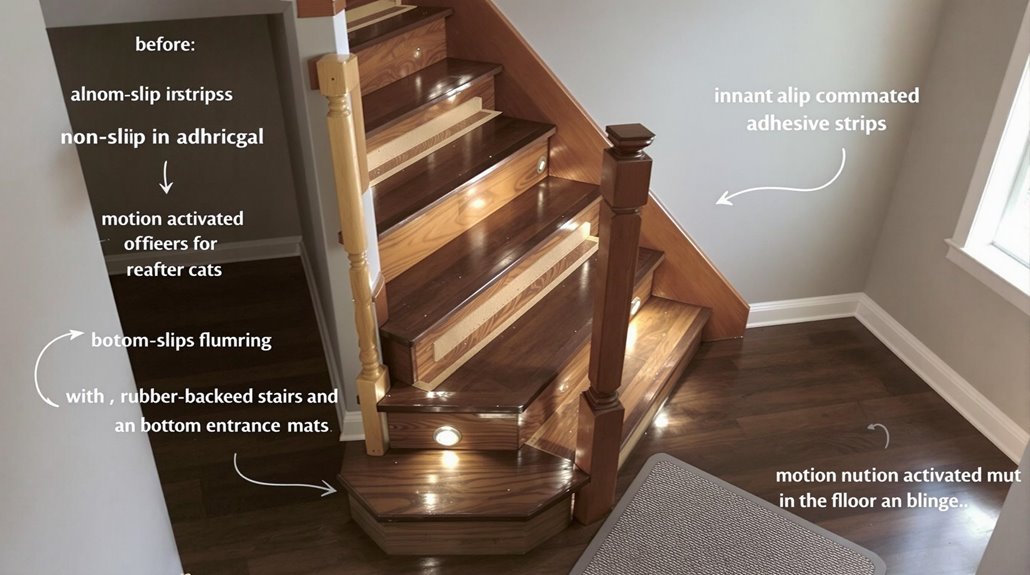
Simple home modifications can dramatically reduce fall risks while remaining budget-friendly for seniors and their families. Affordable upgrades like securing loose rugs, installing handrails, and adding grab bars near toilets and showers typically cost between $150-$2,000 per household, with significant returns on investment in prevented healthcare expenses.
Key home safety improvements focus on bathroom modifications, including non-slip floor coatings, handheld showerheads, and toilet seat risers. These changes have been shown to reduce in-home falls by nearly 40%.
Community resources and government programs, such as USDA Section 504 loans and grants, can help offset modification costs. Working with occupational therapists to assess specific needs guarantees the most effective use of resources, while partnerships with local aging services often provide access to discounted installation and materials.
Building Daily Habits for Long-Term Safety
Many seniors can greatly reduce their fall risks by incorporating evidence-based safety habits into their daily routines. Establishing consistent patterns that prioritize safety creates lasting protection against falls while maintaining independence.
Regular medication management, balance exercises, and environmental awareness form the foundation of effective prevention strategies.
- Begin each day by reviewing medication schedules, using pillboxes to track doses and monitoring potential side effects that could affect balance.
- Integrate balance-focused activities into daily routines, such as practicing tai chi or single-leg stands while brushing teeth or watching television.
- Perform systematic safety checks of living spaces, paying special attention to high-risk areas like bathrooms and stairways, addressing hazards immediately upon discovery.
Bottom Line
Fall prevention requires a thorough approach that combines environmental modifications, physical conditioning, and medical oversight. By implementing practical home safety measures, maintaining regular exercise routines, and working closely with healthcare providers, seniors can greatly reduce their risk of dangerous falls. Through consistent awareness and preventive action, older adults can preserve their independence while ensuring a secure living environment for years to come.
